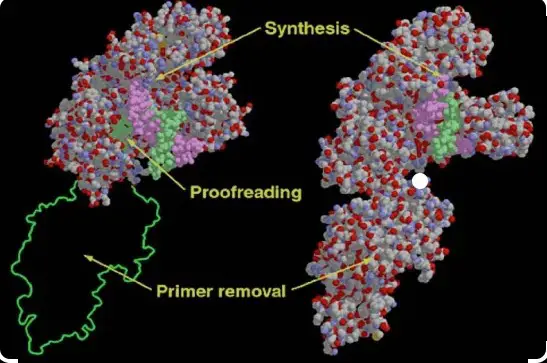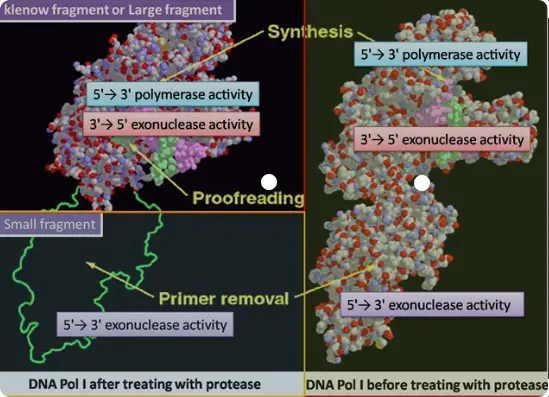DNA polymerase enzymes are fundamental to the biological process of DNA replication and repair, each with specific roles and mechanisms. Among these, DNA Polymerase I and its derivative, the Klenow Fragment, are significant in the context of molecular biology and genetic engineering. Initially identified and isolated from Escherichia coli, these enzymes have opened new avenues in DNA manipulation and research.
The Klenow Fragment is a large protein fragment obtained by the enzymatic cleavage of DNA Polymerase I, lacking the 5’→3′ exonuclease activity of the parent enzyme. This alteration allows it to perform specific functions that are crucial in the laboratory setting, such as DNA labeling and sequencing. DNA Polymerase I, on the other hand, retains comprehensive activities including 5’→3′ DNA synthesis, 3’→5′ proofreading, and 5’→3′ exonuclease activities, making it indispensable for DNA replication and repair.
Both enzymes play critical roles in molecular biology, with their distinct functions deriving from their structural differences. While the Klenow Fragment is used primarily for high-fidelity synthesis in research applications, DNA Polymerase I is essential for its exhaustive enzymatic activities in vivo, impacting genetic replication and stability.

Klenow Fragment Basics
Definition and Origin
The Klenow Fragment is a large protein fragment derived from DNA Polymerase I, which is found in Escherichia coli. The fragment was first discovered in the late 1960s by scientists who were studying the structure and function of DNA Polymerase I. It was named after the researcher Thomas Klenow, who was instrumental in elucidating its properties.
This fragment retains the 3’→5′ exonuclease activity and the 5’→3′ polymerase activity of the parent enzyme but lacks the 5’→3′ exonuclease component. This unique feature makes the Klenow Fragment particularly useful for various applications in molecular biology, notably in DNA sequencing and labeling.
Production Process
The production of the Klenow Fragment is a clear example of targeted enzymatic modification. Here’s how it is typically produced:
- Start with DNA Polymerase I: The process begins with the full enzyme, DNA Polymerase I.
- Enzymatic Cleavage: The enzyme is treated with a specific protease, which cleaves the DNA Polymerase I molecule.
- Separation of Fragments: After cleavage, the smaller fragment containing the 5’→3′ exonuclease activity is removed.
- Purification: The remaining larger fragment, now called the Klenow Fragment, is purified for use in various applications.
This method allows researchers to obtain a tool that is essential for high-precision genetic engineering tasks.

DNA Polymerase I Overview
Definition and Function
DNA Polymerase I is a crucial enzyme in the process of DNA replication, playing a multifaceted role in cellular life. It was the first DNA polymerase to be isolated from Escherichia coli by Arthur Kornberg in 1956, earning him a Nobel Prize. The enzyme is responsible for several vital functions:
- DNA Synthesis: It synthesizes DNA by adding nucleotides to a DNA strand.
- Error Correction: Its 3’→5′ exonuclease activity allows it to correct errors in newly synthesized DNA, enhancing the fidelity of DNA replication.
- Primer Removal: It also possesses 5’→3′ exonuclease activity, which is critical for removing RNA primers from Okazaki fragments on the lagging strand during DNA replication.
Structure and Components
The structure of DNA Polymerase I is complex and includes several distinct domains that contribute to its functionality:
- Polymerase Core: This is where the DNA synthesis activity occurs.
- 3’→5′ Exonuclease Domain: This domain is involved in proofreading newly synthesized DNA.
- 5’→3′ Exonuclease Domain: This part of the enzyme is essential for primer removal.
Each component is essential for the enzyme’s role in DNA replication and repair, underscoring the enzyme’s complexity and importance.
Key Differences
Enzymatic Activity
The Klenow Fragment and DNA Polymerase I differ significantly in their enzymatic activities. The Klenow Fragment is designed specifically for activities that require the absence of the 5’→3′ exonuclease function:
- DNA Polymerase I: Offers comprehensive DNA synthesis and repair functions, including exonuclease activities.
- Klenow Fragment: Focuses on synthesizing DNA without degrading the DNA ahead of it, making it ideal for tasks requiring high accuracy without RNA primer removal.
Structural Variations
Structurally, the main difference between the Klenow Fragment and DNA Polymerase I lies in the absence of the 5’→3′ exonuclease domain in the Klenow Fragment. This variation means that the Klenow Fragment cannot remove primers but is excellent for adding nucleotides at the 3′ end of the DNA strand.
Applications in Biotechnology
The unique properties of both the Klenow Fragment and DNA Polymerase I have led to their widespread use in biotechnology:
- Klenow Fragment:
- DNA Sequencing: It is extensively used in Sanger sequencing to synthesize complementary DNA strands.
- Labeling DNA: It can incorporate labeled nucleotides to produce visibly marked DNA.
- DNA Polymerase I:
- DNA Repair: It is crucial for repairing DNA in vivo.
- Cloning Technologies: It is used in cloning to replace RNA primers with DNA.

Functional Implications
Role in DNA Replication
DNA Polymerase I and the Klenow Fragment are pivotal in DNA replication, each serving distinct roles that ensure the process is accurate and efficient. DNA Polymerase I’s multi-functional nature allows it to handle various tasks:
- Synthesis of DNA: It adds nucleotides to the growing DNA strand.
- Proofreading: The enzyme’s 3’→5′ exonuclease activity checks and corrects errors, ensuring high fidelity.
- Primer Removal: Its 5’→3′ exonuclease activity removes RNA primers, replacing them with DNA.
The Klenow Fragment, on the other hand, specializes in adding nucleotides without the capability to remove RNA primers, which is beneficial for certain laboratory applications requiring uninterrupted, high-fidelity DNA synthesis.
Usage in Genetic Research
Both enzymes are extensively utilized in genetic research due to their specific capabilities:
- DNA Polymerase I: Its comprehensive activities are essential for experiments involving DNA replication and repair mechanisms.
- Klenow Fragment: It is used in DNA sequencing, labeling, and modifying DNA structures for cloning and analysis.
Their applications are crucial for advancing our understanding of genetic functions and developing new genetic manipulation technologies.
Comparative Analysis
Efficiency in DNA Synthesis
In terms of efficiency, the Klenow Fragment and DNA Polymerase I have different operational strengths. The Klenow Fragment is highly efficient in synthesizing DNA strands during sequencing because it lacks the 5’→3′ exonuclease activity, which can interfere with the incorporation of chain-terminating nucleotides. DNA Polymerase I, however, is indispensable in vivo where complete synthesis and repair mechanisms are necessary.
Specificity and Error Rates
The specificity and error rates of these enzymes also differ:
- DNA Polymerase I exhibits high specificity and a lower error rate due to its inherent proofreading capability.
- Klenow Fragment, lacking the 5’→3′ exonuclease activity, focuses on polymerization with minimal interruption, suitable for applications where precise DNA synthesis is required without subsequent editing.
Technological Applications
Uses in PCR Technologies
The Klenow Fragment has specific uses in PCR technologies, particularly in labeling and sequencing applications. It is often used to add specific labels or modifiers to the DNA, which are essential for certain types of PCR analyses, such as those used in diagnostic assays.
Advancements in Gene Cloning
Both enzymes have facilitated significant advancements in gene cloning:
- DNA Polymerase I is used to fill in gaps in DNA sequences and replace RNA primers with DNA, a crucial step in cloning vectors.
- Klenow Fragment is often used to generate blunt ends from sticky ends, making it easier to clone specific segments of DNA.
These advancements have not only improved the efficiency of cloning techniques but also increased the range of genetic material that can be cloned.
Challenges and Solutions
Limitations in Use
Despite their advantages, both enzymes face limitations:
- DNA Polymerase I can sometimes be too bulky or slow for certain high-throughput applications.
- Klenow Fragment, while specialized, does not offer the holistic capabilities required for full DNA replication and repair, limiting its use in vivo.
Recent Innovations
Recent innovations have focused on overcoming these limitations:
- Modified Enzymes: Scientists have engineered versions of these enzymes with altered properties to enhance their functionality and reduce limitations.
- Combinatorial Approaches: Using a combination of enzymes, including DNA Polymerase I and the Klenow Fragment, has proven effective in scenarios where the strengths of one complement the weaknesses of the other.
Frequently Asked Questions
What is DNA Polymerase I?
DNA Polymerase I is an enzyme found in bacteria that plays a critical role in DNA replication and repair. It possesses multiple enzymatic activities, including the ability to synthesize DNA, proofread newly synthesized DNA, and remove RNA primers from DNA fragments.
How is the Klenow Fragment produced?
The Klenow Fragment is produced from DNA Polymerase I by enzymatic cleavage with protease, which removes a small fragment of the enzyme that contains the 5’→3′ exonuclease activity, leaving the 3’→5′ proofreading and 5’→3′ polymerase activities intact.
What are the main uses of the Klenow Fragment?
The Klenow Fragment is widely used in molecular biology for applications such as DNA sequencing, DNA labeling, and creating blunt ends from sticky-ended DNA for cloning purposes. Its ability to synthesize DNA in the absence of exonuclease activity makes it particularly useful for these precision tasks.
How do DNA Polymerase I and the Klenow Fragment differ in function?
While DNA Polymerase I possesses both polymerization and exonuclease activities essential for DNA replication and repair, the Klenow Fragment is specifically utilized for tasks that require high-fidelity DNA synthesis without the interference of exonuclease activity.
Conclusion
The distinct characteristics and applications of DNA Polymerase I and the Klenow Fragment highlight their significance in both natural DNA processes and biotechnological applications. Their study not only enhances our understanding of cellular mechanisms but also empowers various scientific and medical advancements.
As research continues, the potential to further harness and refine these enzymes promises new solutions to current challenges in genetic engineering and molecular biology, paving the way for innovative therapeutic strategies and diagnostic tools.

